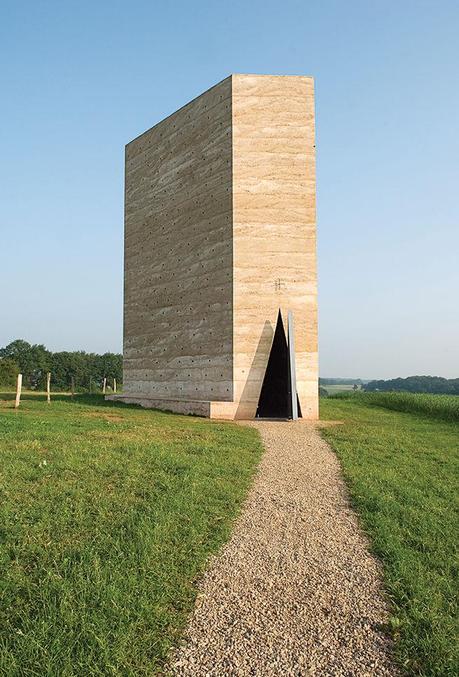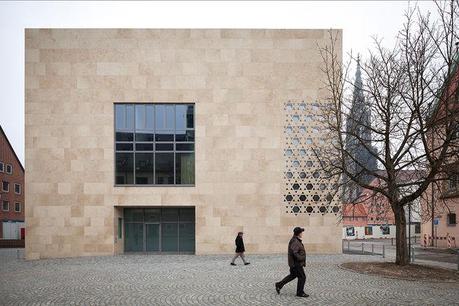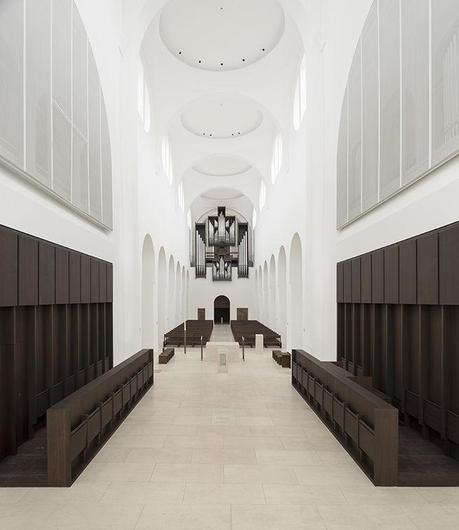
Swiss architect Peter Zumthor— himself considered a bit of a enigma in a world that lauds celebrity designers—built the tiny Bruder Klaus Field Chapel in western Germany in 2007. The structure was created by arranging 112 spruce trees, pouring concrete on top until it set, then burning the wood, leaving a charred interior cavity.
Image courtesy of Thomas Mayer.Sacred buildings fulfill a multitude of requirements, from the programmatic to the sacramental to the symbolic. Tangible links between the human and the divine, they serve not only as places for meditation, celebration, and community but also as testaments to something more abstract: faith.
Since World War II, modern religious architecture has relied less on historical styles and traditional symbolism than on novel forms and solutions, as in Peter Zumthor’s Bruder Klaus Field Chapel, in Mechernich, Germany, which pays homage to the 15th-century Swiss mystic Nicholas of Flüe. It was built on a framework of tree trunks, atop which layers of concrete were poured and rammed. The logs were slowly burned, leaving a blackened chamber lit by an opening in the roof above and holes bored through the walls. “To me, buildings can have a beautiful silence,” says Zumthor. “A building that is being itself, being a building, not representing anything, just being.”
But religious architecture also continues to communicate place and history. When the Nazis destroyed their synagogue in 1938, the Orthodox Jewish community of Ulm, Germany, found itself without a permanent home. Nearly 75 years later, the Weinhof Synagogue and community center opened near the site of the original. The architecture firm Kister Scheithauer Gross oriented the freestanding cube to point to Jerusalem. In the room holding the Torah, the limestone facade has been pierced with a Star of David motif, the 600 openings subtly articulating the building’s function by day or night.
Slideshow

A freestanding, cuboid structure, the synagogue is signifcantly lower and more compact than its neighbors.
Image courtesy of Yohan Zerdan.When British designer John Pawson was tapped to transform St. Moritz Church in Augsburg, Germany, he found that fire, war, and time had all left their mark on the 11th-century structure. He infused the interiors with a bracing purity, a task that required “the meticulous paring away of selected elements of the church’s complex fabric,” he says. Light was key, from LED fixtures illuminating columns, arches, and domes to sunlight filtering through thin slices of onyx in the apse—an effect that he says “functions architecturally as a source of light and liturgically as an expression
of the threshold to transcendence.”
Thousands of miles away, off I-49 in Springdale, Arkansas, architect Marlon Blackwell achieved simplicity of a different sort at St. Nicholas Antiochian Orthodox Christian Church. Constrained by an existing building that was once a metal shop, and a budget of $100 per square foot, Blackwell placed a narrow addition along the western portion of the property to orient the existing structure eastward, in the Eastern Orthodox tradition, allowing for a skylit tower that defines the entrance to the sanctuary. “We used glass at the corners for a more volumetric introduction of light—it was almost surgical,” Blackwell says. The dome is a discarded satellite dish, adorned with an icon of Christ. Blackwell’s reuse of materials prompted the jury that recognized the project with a 2013 AIA Honor Award to note that the design “makes the most with the least, displaying deep resource efficiency as an integral part of its design ethos—something more architects should be thinking about and practicing.”
Architect Shigeru Ban has been reusing materials since the 1980s, when he first experimented with industrial-grade paper tubes. When New Zealand’s Gothic Revival ChristChurch Cathedral was devastated by a 6.3-magnitude earthquake in 2011, the Anglican community turned to Ban to create a transitional home. He responded with a simple A-frame design incorporating 98 paper tubes set atop eight steel shipping containers, topped by a polycarbonate roof. “Even concrete buildings can be destroyed by earthquakes,” says Ban. “But paper buildings cannot.”
Slideshow

Certain religious artifacts were relocated in order to achieve a clearer visual field inside the church.
Image courtesy of Gilbert McCarragher.Other new religious buildings reject conventional typologies entirely. Outside Istanbul, a rectangular stone minaret rises from the 13,000-square-foot Sancaklar Mosque, which doesn’t so much rest on the land as become one with it, owing to Emre Arolat Architects’ intention to emphasize essence over form. Reached by stone steps that descend from the parking area, the mosque is a serene, cave-like space. Walls of slate and poured-in-place concrete define the 700-square-foot prayer hall, where a narrow skylight illuminates the Qiblah, signaling Mecca, which Muslims face during prayer.
Further distilling religious space to its essence, Pieterjan Gijs and Arnout Van Vaerenbergh, of Gijs Van Vaerenbergh, played with the church form itself in rural Belgium in their surrealistic structure titled “Reading Between the Lines,” which is composed of horizontally stacked steel plates. The architects used 30 tons of steel to create a semitransparent work of art that appears as alternately solid and part of the landscape.
With religious attendance declining, along with signs of increasing secularism, the future of sacred architecture is uncertain. But the past 50 years have seen the creation of spaces that nourish and uplift and that inspire communion with something greater than ourselves.
